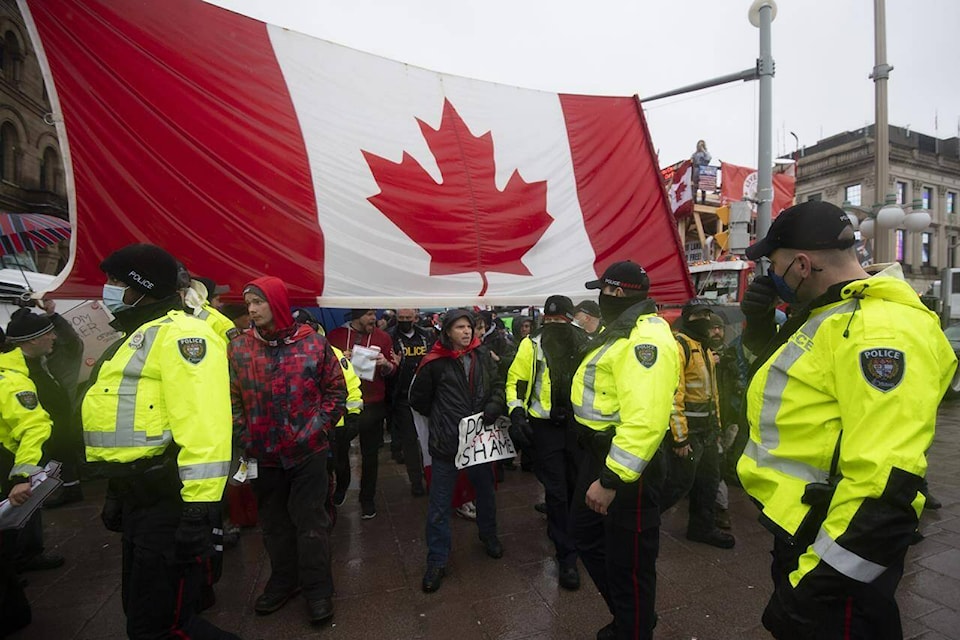The “Freedom Convoy” had gridlocked Canada’s capital city for more than two weeks before the police force approved a detailed plan to handle it, a senior Ottawa police officer told the public inquiry into the Liberal government’s use of the Emergencies Act.
Acting Deputy Chief Patricia Ferguson said Thursday that Ottawa police assumed the protesters would not stay beyond the first weekend and relied at first on a boilerplate plan that had been used for other downtown events involving big crowds, such as Canada Day celebration.
The Ottawa police made no contingency plans, she said.
In hindsight, Ferguson said she would have given more credibility to early warnings from the Ontario Provincial Police and other intelligence suggesting the group planned to stay for weeks.
Police were aware of those warnings, but they weighed it against other intelligence and moved ahead with their standard events plan, she said.
The only contingency plan in place focused entirely on bringing in some extra officers for the weekend and there were no plans to deal with the possibility that protesters would stick around.
It wasn’t until Sunday evening, when nearly 700 trucks did not clear out, that police began to realize their mistake.
“We had been talking about demobilization plan up until that point, and clearly that was not the plan that was going to be required,” she said Thursday.
When the weekend came and went, police realized they needed to “pivot.” But coming up with a plan B proved to be a struggle, Ferguson said, in part because the service did not have officers who were focused solely on the planning.
The other problem Ferguson highlighted was that staff were already exhausted after working the previous week and through the weekend.
“I would describe us as being on our knees and having run a marathon for the last two and a half years, and it felt like they’d moved the finish line 100 yards … and given us 200 pounds to carry to get to the end,” she told the Public Order Emergency Commission, which is scheduled to hold public hearings in downtown Ottawa through to Nov. 25.
“Staffing was, I would say, our number 1 Achilles heel in all of this.”
A formal and approved plan didn’t materialize until Feb. 13, after protesters had occupied the city’s streets for two weeks.
She told the commission that the invocation of the Emergencies Act on Feb. 14 “greased the wheels” of that plan, which culminated in police beginning to clear protesters from the streets on Feb. 18 with the help of more than 2,000 extra officers.
Justice Paul Rouleau, who is leading the commission on the Emergencies Act, asked Ferguson if there was any contingency that involved allowing the protest to continue lawfully.
“I don’t know if those conversations were happening,” Ferguson replied.
In the meantime, Ferguson said a certain level of lawlessness set in around downtown Ottawa, and police were so stretched that they weren’t able to investigate every serious incident that was reported to them.
As the service tried to come up with a way forward, Ferguson said the chief of Ottawa police at the time, Peter Sloly, started directing operations outside of the chain of command.
He asked for a plan focused on public order, which would typically be developed alongside strategies to deal with traffic and other elements, Ferguson said. That public-order plan never materialized.
Ferguson said a real plan was not outlined on paper until Feb. 9, more than a week after the protesters arrived.
In her notes from a meeting, she recorded that Sloly said of anyone who undermined the plan: “I will crush them.”
“I was aghast at the comment,” said Ferguson, who had arguments with the chief about the aggressive nature of “the plan” and advocated for negotiating with protesters.
A scathing assessment of the response up to that point was prepared by a team of partner agencies, including the RCMP, OPP and subject matter experts from other police services called the “integrated planning cell.”
The report described the response as of Feb. 10 as reactive, tactical, aggressive and risky, and “not intelligence led.”
The planning group also suggested the Ottawa Police Service was focused on maintenance, not on resolving the protest, which Ferguson said was true because of the number of officers available.
In an interview with the commission, presented as evidence during her testimony, Ferguson noted that Sloly “may have been distrustful” of the planning team because he knew some of the people from his time serving in Toronto, including that city’s former police chief, Emergency Preparedness Minister Bill Blair.
In earlier testimony, the head of the OPP’s provincial operations intelligence bureau told the commission he did not see direct evidence of the threat of extremist violence among the protesters.
“Everyone was asking about extremism, we weren’t seeing a lot of it,” Supt. Pat Morris said in his testimony Wednesday.
He said the lack of violent crime was “shocking,” and that many political and media reports that suggested the protest was influenced by Russia or Americans and characterized the protesters as extremists were “problematic.”
During cross-examination, he told a lawyer representing the Freedom Convoy organizers the OPP had no credible intelligence of espionage, sabotage or threats of physical violence or damage to property that might be committed by individuals with political, religious or ideological motivations.
However, his testimony was contradicted by reports from his agency and others, including notes from a Jan. 24 meeting between intelligence agencies that indicated it was clear the protest was “garnering a lot of support” and raising millions of dollars, with more groups getting involved, including “the farmers and right-wing extremists calling for major disruptions.”
